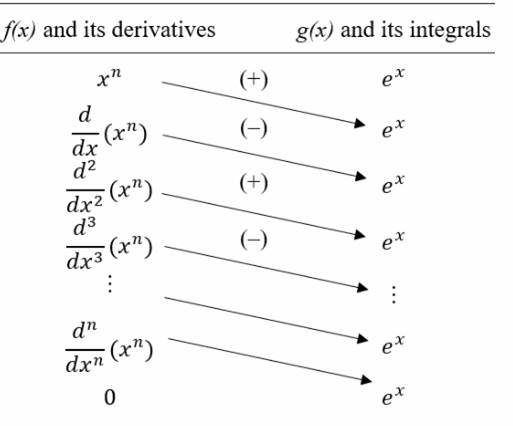
(a)
To find: The integral.
(a)
Answer to Problem 42E
The integral is:
Explanation of Solution
Given information:
The
Calculation:
Put
Use integration by parts
Let,
Then,
Evaluate the remaining integral after rewriting it using integration by parts.
The required integral of the given integration
(b)
To find: The integral.
(b)
Answer to Problem 42E
The integral is:
Explanation of Solution
Given information:
The integration is
Calculation:
Put
Use integration by parts
Let,
Then,
Evaluate the remaining integral after rewriting it using integration by parts.
From part (a)
The required integral of the given integration
(c)
To find: The integral.
(c)
Answer to Problem 42E
The integral is:
Explanation of Solution
Given information:
The integration is
Calculation:
Put
Use integration by parts
Let,
Then,
Evaluate the remaining integral after rewriting it using integration by parts.
From part (b)
The required integral of the given integration
(d)
To find: The value of the integral for any positive integer of
(d)
Answer to Problem 42E
The integral is:
Explanation of Solution
Given information:
The integration is
Calculation:
When
When
When
The outcomes were of the form
Each polynomial's terms contain alternating signs that begin with +. Aside from the + or -, each phrase is also the derivative of the one before it.
The polynomials are then of the form
The integral's outcome can then be expressed in write as:
Therefore the required value of the integral for any positive integer of
(e)
To check: The convincing argument that conjecture in part (d) is true or false,
(e)
Answer to Problem 42E
The option (d) is true.
Explanation of Solution
Given information:
The integration is
Calculation:
From part d)
Use tubular integration
Then gives,

To use the operation signs above each arrow, combine the results of the functions connected by the arrows to produce:
The last term has a sign of
Therefore, the required conjecture from part d) is true.
Chapter 6 Solutions
Advanced Placement Calculus Graphical Numerical Algebraic Sixth Edition High School Binding Copyright 2020
- Number 4 plsarrow_forwardGood Day, Would appreciate any assistance with this query. Regards,arrow_forwardThis question builds on an earlier problem. The randomized numbers may have changed, but have your work for the previous problem available to help with this one. A 4-centimeter rod is attached at one end to a point A rotating counterclockwise on a wheel of radius 2 cm. The other end B is free to move back and forth along a horizontal bar that goes through the center of the wheel. At time t=0 the rod is situated as in the diagram at the left below. The wheel rotates counterclockwise at 1.5 rev/sec. At some point, the rod will be tangent to the circle as shown in the third picture. A B A B at some instant, the piston will be tangent to the circle (a) Express the x and y coordinates of point A as functions of t: x= 2 cos(3πt) and y= 2 sin(3t) (b) Write a formula for the slope of the tangent line to the circle at the point A at time t seconds: -cot(3πt) sin(3лt) (c) Express the x-coordinate of the right end of the rod at point B as a function of t: 2 cos(3πt) +411- 4 -2 sin (3лt) (d)…arrow_forward
 Calculus: Early TranscendentalsCalculusISBN:9781285741550Author:James StewartPublisher:Cengage Learning
Calculus: Early TranscendentalsCalculusISBN:9781285741550Author:James StewartPublisher:Cengage Learning Thomas' Calculus (14th Edition)CalculusISBN:9780134438986Author:Joel R. Hass, Christopher E. Heil, Maurice D. WeirPublisher:PEARSON
Thomas' Calculus (14th Edition)CalculusISBN:9780134438986Author:Joel R. Hass, Christopher E. Heil, Maurice D. WeirPublisher:PEARSON Calculus: Early Transcendentals (3rd Edition)CalculusISBN:9780134763644Author:William L. Briggs, Lyle Cochran, Bernard Gillett, Eric SchulzPublisher:PEARSON
Calculus: Early Transcendentals (3rd Edition)CalculusISBN:9780134763644Author:William L. Briggs, Lyle Cochran, Bernard Gillett, Eric SchulzPublisher:PEARSON Calculus: Early TranscendentalsCalculusISBN:9781319050740Author:Jon Rogawski, Colin Adams, Robert FranzosaPublisher:W. H. Freeman
Calculus: Early TranscendentalsCalculusISBN:9781319050740Author:Jon Rogawski, Colin Adams, Robert FranzosaPublisher:W. H. Freeman
 Calculus: Early Transcendental FunctionsCalculusISBN:9781337552516Author:Ron Larson, Bruce H. EdwardsPublisher:Cengage Learning
Calculus: Early Transcendental FunctionsCalculusISBN:9781337552516Author:Ron Larson, Bruce H. EdwardsPublisher:Cengage Learning





